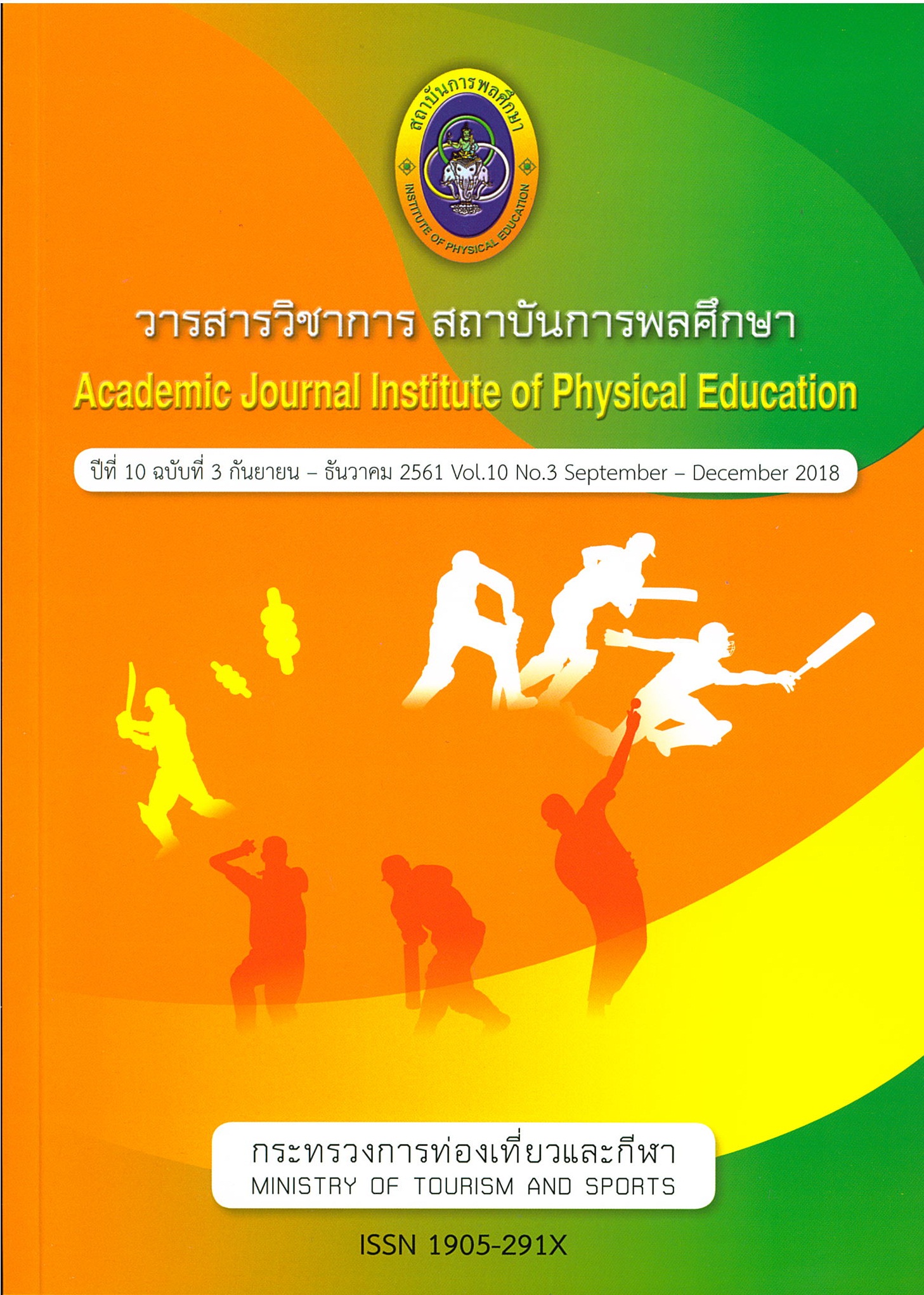Effects of Supplementary Biofrrdback Training on Anxiety Level and Free Throw Shooting Performance In Basketball of Female Chulalongkorn University Basketball Team
Main Article Content
Abstract
Purpose
The purpose of this research was to study effects of supplementary biofeedback training on anxiety level and free throw shooting performance in basketball
Methods
Twenty membersof female Chulalongkorn University basketball teams were equally divided intoexperimental and control groups (ages average19.6 years).Participants in both groups similarly received free throw shooting training but only. The experimental group received heart rate variability biofeedback training 20 minutes a day, 3 days a week for 4 consecutive weeks. Pretest and posttest for heart rate variability, anxiety level (test with CSAI-2R) and free throw shooting accuracy in 30-seconds time limit were conducted on all participants. Means and standard deviation of the obtained data were compared using paired sample t-test for within group differences. Independent t-test was used to analyze data betweenthe experimental and control groups. Alpha level was set at p < .05. with G*Power Program
Results
The results showed significant-improvement of anxiety level, heart rate variability and free throw shooting accuracy (p < 0.05) in the experimental group. While only selfconfidence score was significantly increased (p < 0.05) for the control group. Furthermore, heart rate variability and free throw shooting accuracy were significantly greater inexperimental group thanincontrol group (p < 0.05), butno difference was found inanxiety level between two groups of participants.
Conclusion
Heart rate variability biofeedback of the experimental group could improve anxiety level, heart rate variability, heart rate while shooting and free throw shooting accuracy.
Article Details
The published article is a copyright of the Academic Journal of Thailand National Sports University. The passage appeared in each article in this academic journal is a perspective of each author which is not related to the journal. Each author is required to be responsible for all components of his/her own article. If there are any mistakes, each author must be responsible for those mistakes on his/her own.
References
เตชภาส มากคง. (2556). ผลของโปรแกรมการฝึกไบโอฟีดแบคที่มีต่อความวิตกกังวลและความแม่นยำในการยิงปืนของนักกีฬายิงปืนระดับมัธยมศึกษา. วิทยานิพนธ์ปริญญามหาบัณฑิต, สาขาวิชาวิทยาศาสตร์การกีฬา คณะวิทยาศาสตร์การกีฬา จุฬาลงกรณ์มหาวิทยาลัย.
พีรพงศ์บุญศิริ. (2536). จิตวิทยาการกีฬา. กรุงเทพฯ: ห้างหุ้นส่วนจำกัดโอเดียนสโตร์.
มรรยาท รุจิวิชชญ์. (2556). การจัดการความเครียดเพื่อสร้างเสริมสุขภาพจิต. ปทุมธานี: โรงพิมพ์มหาวิทยาลัยธรรมศาสตร์.
รัชเดชเครือทิวา. (2553). ผลการฟังดนตรีควบคู่กับการฝึกจินตภาพที่มีต่อความแม่นยำในการยิงประตูโทษบาสเกตบอล. วิทยานิพนธ์ปริญญามหาบัณฑิต, สาขาวิชาพลศึกษา คณะพลศึกษา มหาวิทยาลัยศรีนครินทร์วิโรฒ.
โรจพล บูรณรักษ์. (2547). การเปรียบเทียบผลของการฝึกเสริมการยิงประตูที่มีต่อความสามารถในการยิงประตูโทษของกีฬาบาสเกตบอล. วิทยานิพนธ์ปริญญามหาบัณฑิต, สาขาวิชาพลศึกษา คณะครุศาสตร์ จุฬาลงกรณ์มหาวิทยาลัย.
ศิริรัตน์ เปลี่ยนบางยาง. (2533). ผลของการฝึกอีเอ็มจีไบโอฟีดแบคร่วมกับการผ่อนคลายกล้ามเนื้อต่ออาการปวดศีรษะในผู้ป่วยที่มีอาการปวดศีรษะจากความเครียด. วิทยานิพนธ์ปริญญามหาบัณฑิต, สาขาวิชาพยาบาลศาสตร์บัณฑิตวิทยาลัย มหาวิทยาลัยมหิดล.
ศิลปชัย สุวรรณธาดา. (2552) เอกสารคำสอน วิชา 3903301 จิตวิทยาการกีฬา 1. กรุงเทพฯ: คณะวิทยาศาสตร์การกีฬา จุฬาลงกรณ์มหาวิทยาลัย.
สืบสาย บุญวีรบุตร. (2541). จิตวิทยาการกีฬา. ชลบุรี: ชลบุรีการพิมพ์.
สุปราณี ขวัญบุญจันทร์. (2541). จิตวิทยาการกีฬา. กรุงเทพฯ: บริษัท โรงพิมพ์ไทยวัฒนพานิช จำกัด.
สุพัชรินทร์ ปานอุทัย. (2556).จิตวิทยาการกีฬา.กรุงเทพฯ:กรมพลศึกษา กระทรวงการท่องเที่ยวและกีฬา.
Blasquez, J. C. C., Font, G. R., & Ortis, L. C. (2009). Heart-rate variability and precompetitive anxiety in swimmers. Psicothema, 21(4), 531–536.
Cox, R. H. (2012). Sport psychology: Concept and applications (7TH ed.). USA: McGraw Hill Company.
Cox, R. H., Martens, M. P., & Russel, W. D. (2003). Measuring anxiety in athletics: The revised Competitive State Anxiety Inventory-2. Journal of Sport and Exercise Psychology, 25, 519–533
Dziembowska, I., Izdebski, P., Rasmus, A., Brudny, J., Grzelczak, M., & Cysewski, P. (2016). Effects of Heart Rate Variability Biofeedback on EEG Alpha Asymmetry and Anxiety Symptoms in Male Athletes: A Pilot Study. Applied Psychophysiology and Biofeedback, 41(2), 141-150.
Giardino, N. D., Lehrer, P. M., Feldman, J. M., Kenny, D. T., Carlson, J. G., Mcguigan, F. J., & Sheppard, J.L. (2000). The role of oscillations in self-regulation: Their contribution to homeostasis. Amsterdam: Harwood.
Gruzelier, J. H., Thompson, T., Redding, E., Brandt, R., & Steffert, T. (2014). Application of alpha/the taneuro feedback and heart rate variability training to young contemporary dancers: State anxiety and creativity. International Journal of Psychophysiology, 93(1), 105-111.
Humara, M. (2001).The relationship between anxiety and performance: A Cognitive-behavioral perspective. Athletic Insight. The Online Journal of Sport Psychology, 1(2).
Lagos, L., Vaschillo, E., Vaschillo, B., Lehrer, P., Bates, M., & Pandina, R. (2008). Heart rate variability biofeedback as a strategy for dealing with competitive anxiety: A case study. Applied Psychophysiology and Biofeedback, 36(3), 109-115.
Langdeau, J.-B., Turcotte, H., Desgagné, P., Jobin, J., & Boulet, L.-P. (2000). Influence of sympatho-vagal balance on airway responsiveness in athletes. European Journal of Applied Physiology, 83(4), 370-375.
Lehrer,P.,Vaschillo,B., Zucker,T., Graves, J.,Katsamanis, M., Aviles, M., &Wamboldt,F. (2013). Protocol for heart rate variability biofeedback Training. Applied Psychophysiology and Biofeedback, 41(3), 98-109.
Lehrer, P., & Vaschillo, E. (2008). The future of heart rate variability biofeedback. Applied Psychophysiology and Biofeedback, 36(1), 11-14.
Lehrer, P., Vaschillo, E., Lu, S. E., Eckberg, D., Vaschillo, B., Scardella, A., & Habib, R. (2006). Heart rate variability-effects of age on heart rate variability, baroreflex gain, and asthma. Chest Journal, 129, 278-284.
Lehrer, P. M., & Gevirtz, R. (2014). Heart rate variability biofeedback: how and why does it work? Frontiers in Psychology, 5, 1-9.
Lehrer, P. M., Vaschillo, E., Vaschillo, B., Lu, S. E., Eckberg, D. L., Edelberg, R., Hamer, R. M. (2003). Heart rate variability biofeedback increases baroreflex gain and peak expiratory flow. Psychosomatic Medicine, 65(5), 796-805.
Parnabas, V. (2015). The effect of competitive state anxiety on sport performance among sepak takraw athletes. The International Journal of Indian Psychology, 2, 42-51.
Parnabas, V., Parnabas, J., & Parnabas, A. M. (2015). The ralationship between cognitive anxiety and sport performances on basketball. The International Journal of Indian Psychology, 2.
Pate, J., Cummings, A., & Maynard, I. (2002). The effects of hypnosis on flow states and three-point shooting performancein basketball players. The Sport Psychologist, 16, 1-15.
Patmore, A. (1986). Sportsmen under stress. London: Stanley Paul.
Paul, M., & Garg, K. (2012). The effect of heart rate variability biofeedback on performance psychology of basketball players. Applied Psychophysiology and Biofeedback, 37, 131-144.
Sutarto, A. P., Wahab, M. N. A., & Zin, N. M. (2010). Heart Rate Variability (HRV) biofeedback: A new training approach for operator’s performance enhancement. Journal of Industrial Engineering and Management, 3(1), 176-198.
van der Zwan, J.E., deVente, W., Huizink, A. C.,Bogels,S. M., & deBruin,E. I. (2015). Physical activity, mindfulness meditation, or heart rate variability biofeedback for stress reduction: arandomized controlled trial. Applied Psychophysiology and Biofeedback, 40(4), 257-268.


